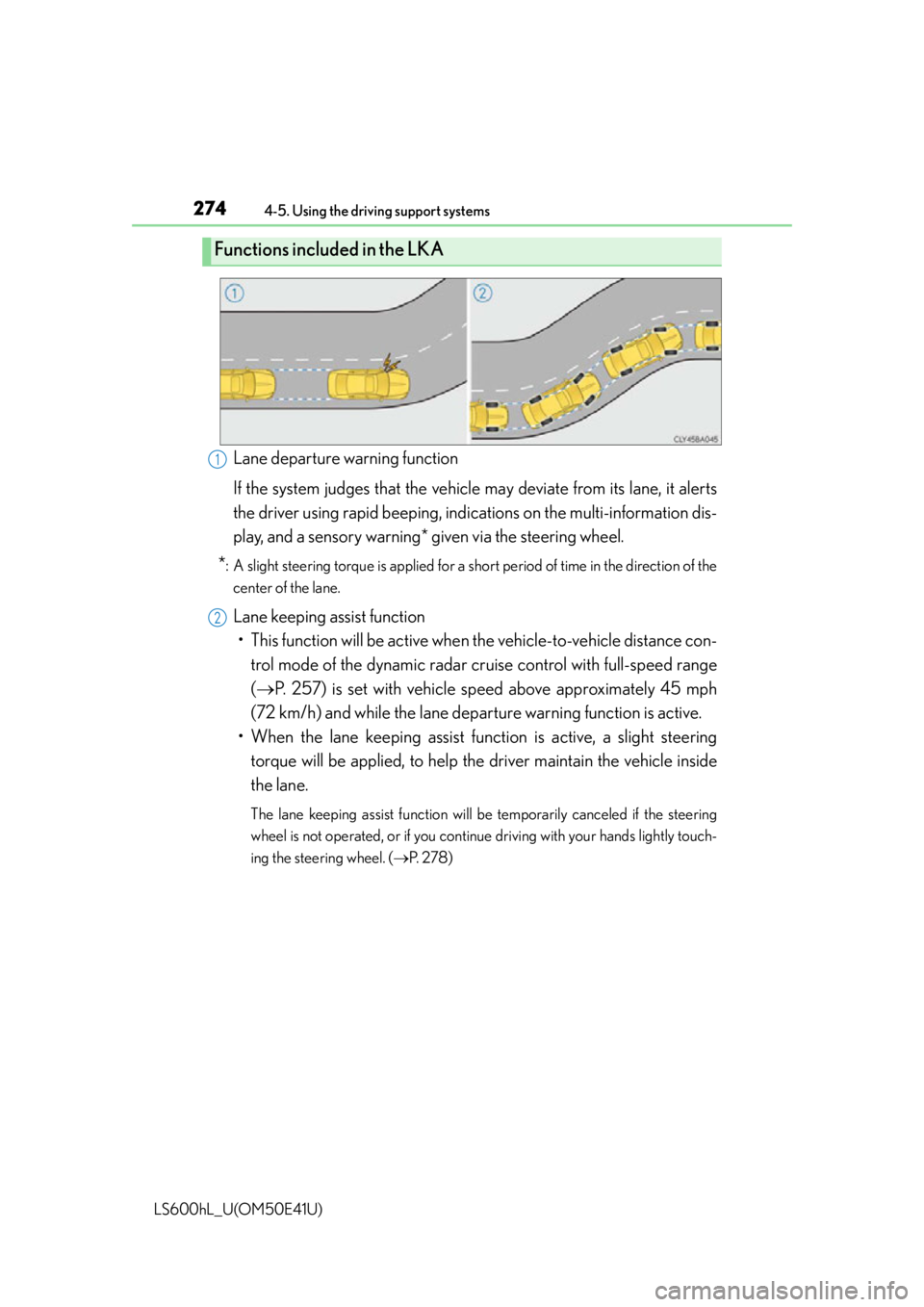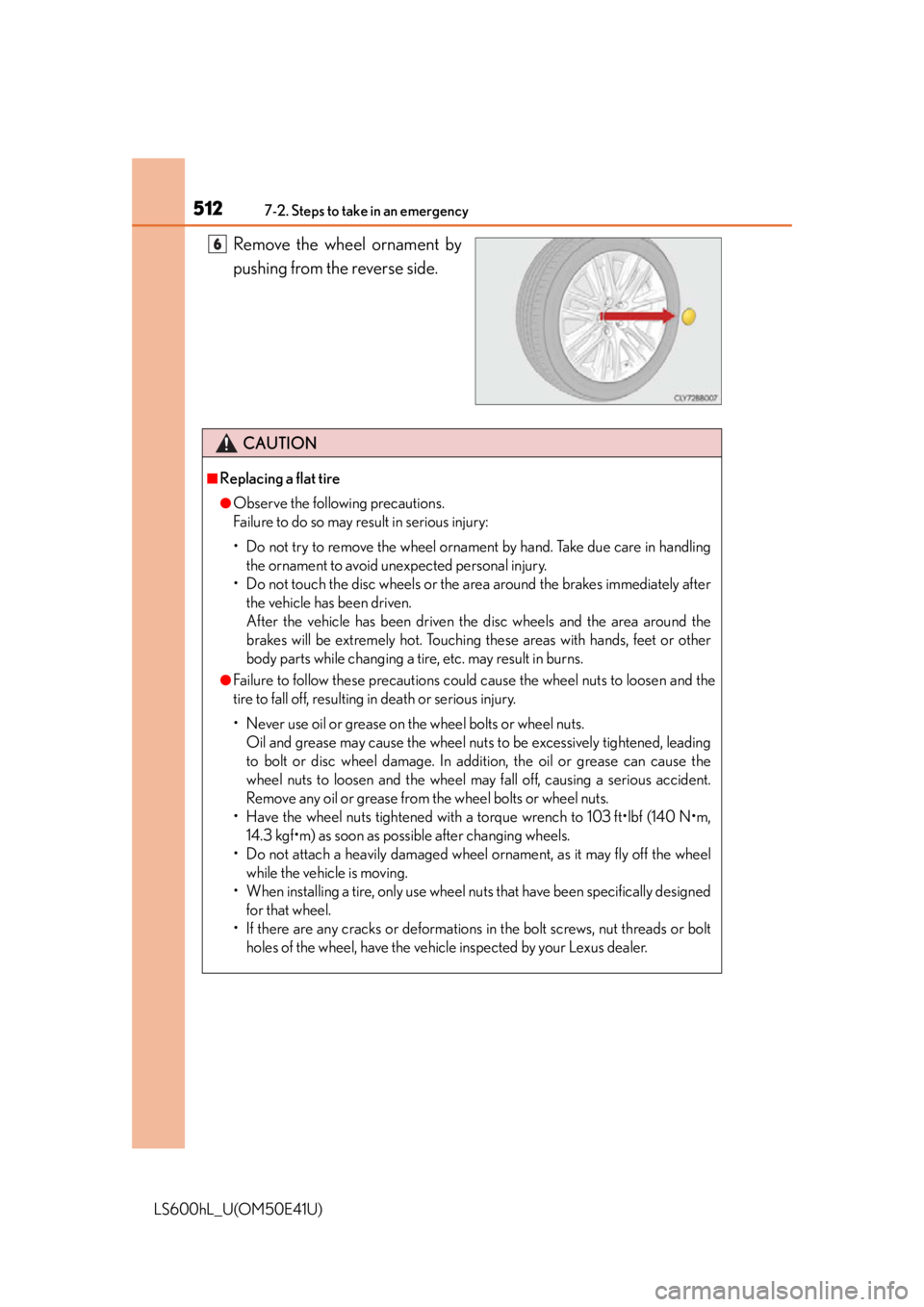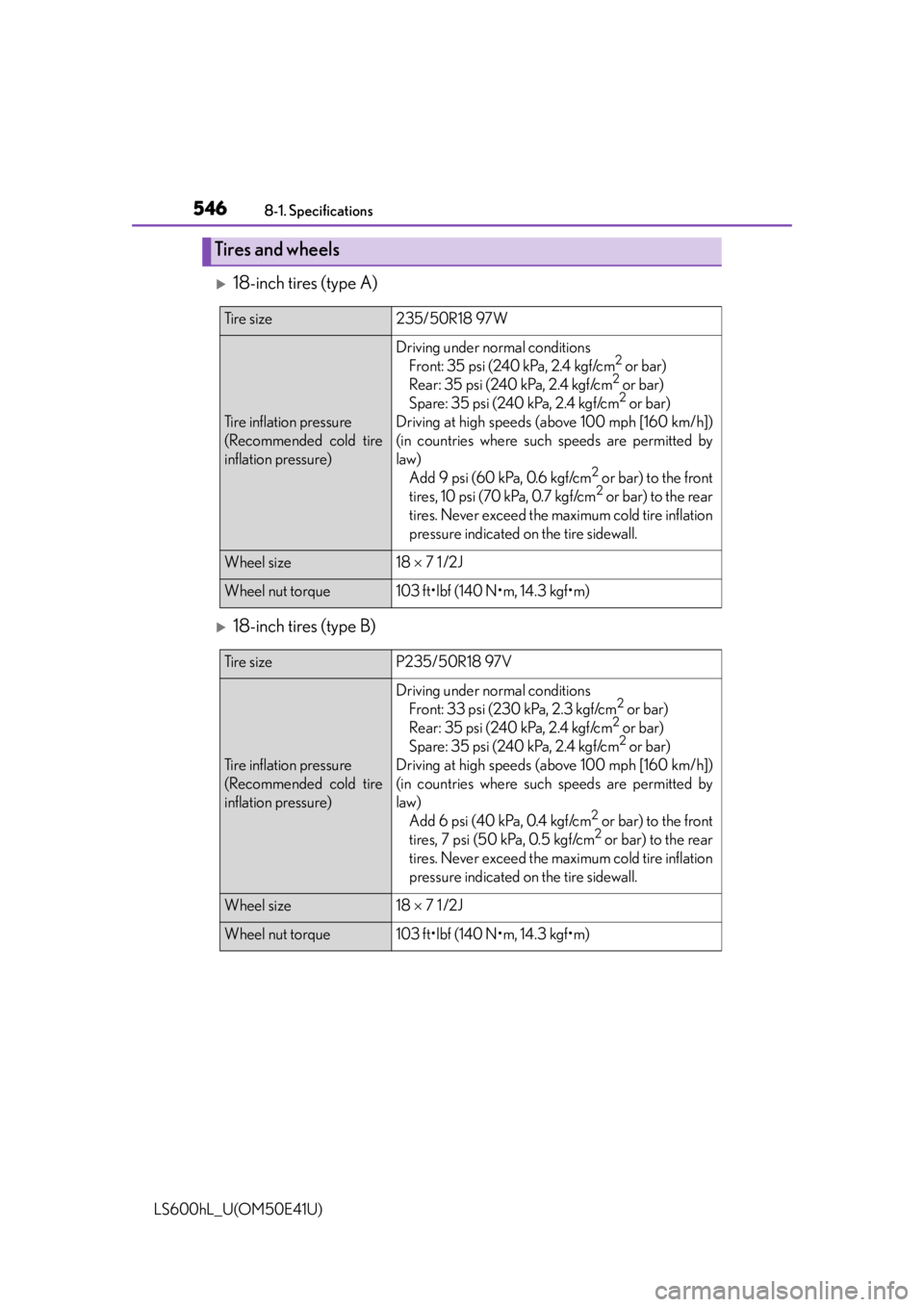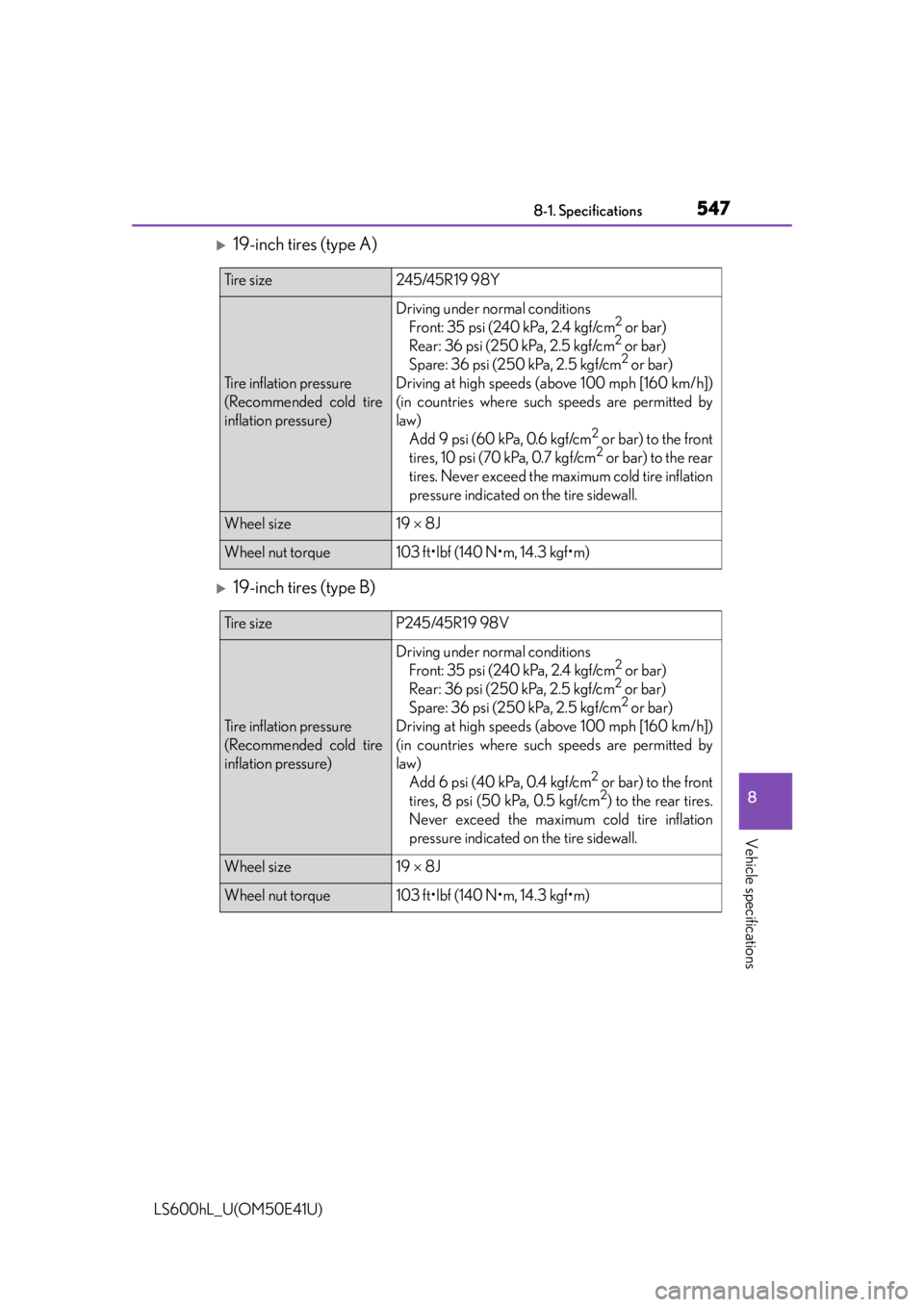Page 209 of 620

2074-1. Before driving
4
Driving
LS600hL_U(OM50E41U)
NOTICE
■When driving the vehicle
●Do not depress the accelerator and brake pedals at the same time during driving,
as this may restrain driving torque.
●Do not use the accelerator pedal or depress the accelerator and brake pedals at
the same time to hold the vehicle on a hill.
■When parking the vehicle
Always shift the shift lever to P. Failure to do so may cause the vehicle to move or
the vehicle may accelerate suddenly if the accelerator pedal is accidentally
depressed.
■Avoiding damage to vehicle parts
●Do not turn the steering wheel fully in either direction and hold it there for an
extended period of time.
Doing so may damage th e power steering motor.
●When driving over bumps in the road, drive as slowly as possible to avoid damag-
ing the wheels, underside of the vehicle, etc.
■If you get a flat tire while driving
A flat or damaged tire may cause the following situations. Hold the steering wheel
firmly and gradually depress the brake pedal to slow down the vehicle.
●It may be difficult to control your vehicle.
●The vehicle will make abnormal sounds or vibrations.
●The vehicle will lean abnormally.
Information on what to do in case of a flat tire ( P. 506, 515)
Page 276 of 620

2744-5. Using the driving support systems
LS600hL_U(OM50E41U)
Lane departure warning function
If the system judges that the vehicle may deviate from its lane, it alerts
the driver using rapid beeping, indi cations on the multi-information dis-
play, and a sensory warning* given via the steering wheel.
*: A slight steering torque is applied for a short period of time in the direction of the
center of the lane.
Lane keeping assist function• This function will be active when the vehicle-to -vehicle distance con-
trol mode of the dynamic radar crui se control with full-speed range
( P. 257) is set with vehicle sp eed above approximately 45 mph
(72 km/h) and while the lane depa rture warning function is active.
• When the lane keeping assist fu nction is active, a slight steering
torque will be applied, to help the driver maintain the vehicle inside
the lane.
The lane keeping assist function will be temporarily canceled if the steering
wheel is not operated, or if you continue driving with your hands lightly touch-
ing the steering wheel. ( P. 2 7 8 )
Functions included in the LKA
1
2
Page 514 of 620

5127-2. Steps to take in an emergency
LS600hL_U(OM50E41U)
Remove the wheel ornament by
pushing from the reverse side.6
CAUTION
■Replacing a flat tire
●Observe the following precautions.
Failure to do so may result in serious injury:
• Do not try to remove the wheel ornament by hand. Take due care in handlingthe ornament to avoid unexpected personal injury.
• Do not touch the disc wheels or the area around the brakes immediately after the vehicle has been driven.
After the vehicle has been driven the disc wheels and the area around the
brakes will be extremely hot. Touching these areas with hands, feet or other
body parts while changing a tire, etc. may result in burns.
●Failure to follow these precautions could cause the wheel nuts to loosen and the
tire to fall off, resulting in death or serious injury.
• Never use oil or grease on the wheel bolts or wheel nuts.Oil and grease may cause the wheel nuts to be excessively tightened, leading
to bolt or disc wheel da mage. In addition, the oil or grease can cause the
wheel nuts to loosen and the wheel may fall off, causing a serious accident.
Remove any oil or grease from the wheel bolts or wheel nuts.
• Have the wheel nuts tightened with a torque wrench to 103 ft•lbf (140 N•m, 14.3 kgf•m) as soon as possible after changing wheels.
• Do not attach a heavily damaged wheel ornament, as it may fly off the wheel while the vehicle is moving.
• When installing a tire, only use wheel nuts that have been specifically designed for that wheel.
• If there are any cracks or deformations in the bolt screws, nut threads or bolt holes of the wheel, have the vehicle inspected by your Lexus dealer.
Page 515 of 620
5137-2. Steps to take in an emergency
7
When trouble arises
LS600hL_U(OM50E41U)
Remove any dirt or foreign mat-
ter from the wheel contact sur-
face.
If foreign matter is on the wheel con-
tact surface, the wheel nuts may
loosen while the vehicle is in motion,
causing the tire to come off.
Install the spare tire and loosely
tighten each wheel nut by hand
by approximately the same
amount.
Turn the wheel nuts until the washers
come into contact with the disc wheel.
Lower the vehicle.
Firmly tighten each wheel nut two
or three times in the order shown
in the illustration.
Tightening torque:
103 ft•lbf (140 N•m, 14.3 kgf•m)
Installing the spare tire
1
Disc wheelWa s h e r2
3
4
Page 548 of 620

5468-1. Specifications
LS600hL_U(OM50E41U)
18-inch tires (type A)
18-inch tires (type B)
Tires and wheels
Ti r e s i z e235/50R18 97W
Tire inflation pressure
(Recommended cold tire
inflation pressure)
Driving under normal conditionsFront: 35 psi (240 kPa, 2.4 kgf/cm2 or bar)
Rear: 35 psi (240 kPa, 2.4 kgf/cm2 or bar)
Spare: 35 psi (240 kPa, 2.4 kgf/cm2 or bar)
Driving at high speeds (above 100 mph [160 km/h])
(in countries where such speeds are permitted by
law) Add 9 psi (60 kPa, 0.6 kgf/cm
2 or bar) to the front
tires, 10 psi (70 kPa, 0.7 kgf/cm2 or bar) to the rear
tires. Never exceed the maximum cold tire inflation
pressure indicated on the tire sidewall.
Wheel size18 7 1 /2J
Wheel nut torque103 ft•lbf (140 N•m, 14.3 kgf•m)
Ti r e s i z eP235/50R18 97V
Tire inflation pressure
(Recommended cold tire
inflation pressure)
Driving under normal conditions
Front: 33 psi (230 kPa, 2.3 kgf/cm2 or bar)
Rear: 35 psi (240 kPa, 2.4 kgf/cm2 or bar)
Spare: 35 psi (240 kPa, 2.4 kgf/cm2 or bar)
Driving at high speeds (above 100 mph [160 km/h])
(in countries where such speeds are permitted by
law) Add 6 psi (40 kPa, 0.4 kgf/cm
2 or bar) to the front
tires, 7 psi (50 kPa, 0.5 kgf/cm2 or bar) to the rear
tires. Never exceed the maximum cold tire inflation
pressure indicated on the tire sidewall.
Wheel size18 7 1 /2J
Wheel nut torque103 ft•lbf (140 N•m, 14.3 kgf•m)
Page 549 of 620

5478-1. Specifications
8
Vehicle specifications
LS600hL_U(OM50E41U)
19-inch tires (type A)
19-inch tires (type B)
Ti r e s i z e245/45R19 98Y
Tire inflation pressure
(Recommended cold tire
inflation pressure)
Driving under normal conditionsFront: 35 psi (240 kPa, 2.4 kgf/cm2 or bar)
Rear: 36 psi (250 kPa, 2.5 kgf/cm2 or bar)
Spare: 36 psi (250 kPa, 2.5 kgf/cm2 or bar)
Driving at high speeds (above 100 mph [160 km/h])
(in countries where such speeds are permitted by
law) Add 9 psi (60 kPa, 0.6 kgf/cm
2 or bar) to the front
tires, 10 psi (70 kPa, 0.7 kgf/cm2 or bar) to the rear
tires. Never exceed the maximum cold tire inflation
pressure indicated on the tire sidewall.
Wheel size19 8J
Wheel nut torque103 ft•lbf (140 N•m, 14.3 kgf•m)
Ti r e s i z eP245/45R19 98V
Tire inflation pressure
(Recommended cold tire
inflation pressure)
Driving under normal conditions
Front: 35 psi (240 kPa, 2.4 kgf/cm2 or bar)
Rear: 36 psi (250 kPa, 2.5 kgf/cm2 or bar)
Spare: 36 psi (250 kPa, 2.5 kgf/cm2 or bar)
Driving at high speeds (above 100 mph [160 km/h])
(in countries where such speeds are permitted by
law) Add 6 psi (40 kPa, 0.4 kgf/cm
2 or bar) to the front
tires, 8 psi (50 kPa, 0.5 kgf/cm2) to the rear tires.
Never exceed the maximum cold tire inflation
pressure indicated on the tire sidewall.
Wheel size19 8J
Wheel nut torque103 ft•lbf (140 N•m, 14.3 kgf•m)
Page 550 of 620
5488-1. Specifications
LS600hL_U(OM50E41U)
19-inch tires (type C)
Ti r e s i z e245/45RF19 98Y
Tire inflation pressure
(Recommended cold tire
inflation pressure)
Driving under normal conditionsFront: 36 psi (250 kPa, 2.5 kgf/cm2 or bar)
Rear: 36 psi (250 kPa, 2.5 kgf/cm2 or bar)
Driving at high speeds (above 100 mph [160 km/h])
(in countries where such speeds are permitted by
law)
Add 9 psi (60 kPa, 0.6 kgf/cm
2 or bar) to the front
tires, 10 psi (70 kPa, 0.7 kgf/cm2 or bar) to the rear
tires. Never exceed the maximum cold tire inflation
pressure indicated on the tire sidewall.
Wheel size19 8J
Wheel nut torque103 ft•lbf (140 N•m, 14.3 kgf•m)